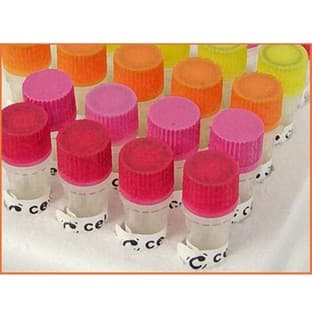
Supplier:
Aviva Systems Biology IncorporatedOPTC (opticin) Blocking Peptide (100ug)
Prices direct from Aviva Systems Biology Incorporated
Quick response times
Exclusive Absave savings/discounts
SPECIFICATIONS
Size
100 ug
Format
Lyophilized powder
Presku
AAP55034
Target
Opticin belongs to class III of the small leucine-rich repeat protein (SLRP) family. Members of this family are typically associated with the extracellular matrix. Opticin is present in significant quantities in the vitreous of the eye and also ocalizes to the cornea, iris, ciliary body, optic nerve, choroid, retina, and fetal liver. Opticin may noncovalently bind collagen fibrils and regulate fibril morphology, spacing, and organization. The opticin gene is mapped to a region of chromosome 1 that is associated with the inherited eye diseases age-related macular degeneration (AMD) and posterior column ataxia with retinosa pigmentosa (AXPC1).Opticin belongs to class III of the small leucine-rich repeat protein (SLRP) family. Members of this family are typically associated with the extracellular matrix. Opticin is present in significant quantities in the vitreous of the eye and also localizes to the cornea, iris, ciliary body, optic nerve, choroid, retina, and fetal liver. Opticin may noncovalently bind collagen fibrils and regulate fibril morphology, spacing, and organization. The opticin gene is mapped to a region of chromosome 1 that is associated with the inherited eye diseases age-related macular degeneration (AMD) and posterior column ataxia with retinosa pigmentosa (AXPC1).
Weight
35kDa
Gene Id
26254
Alternative Names
OPT
Applications
IHC
Hosts
Mouse
Applications
ELISA
Hosts
Mouse
Applications
ELISA
Hosts
Mouse
Applications
ELISA
Hosts
Mouse
Latest promotions
Buy any polyclonal or monoclonal antibody from our extensive range of pre-made antibodies and for a limited time only receive a $50 discount!(T&C apply:...
New brilliant antibodies, and new lower prices!For flow cytometry reagents in general, \"bright is better.\" The violet-excitable BD Horizon™ BV421 and...
We're so sure that you'll prefer Cayman Assay kits over your present brand that we're willing to give you a free assay kit to prove it!
For the past decade scientists have extensively used ATS secondary toxin conjugates to make their own targeted toxins for in vitro use.The ability to combine...
10% Discount on 2 Rabbit Polyclonal Antibody Service. With over 20 years experience, SDIX has developed into the premier US custom antibody producer,...
Did your supplier increase the price of Fetal Bovine Serum? Did they substitute the US Origin with USDA? Well say no more! Innovative Research is still...
Bulk Cytokines with Custom Vialing.20 - 50% off cytokines, growth factors, chemokines and more...For a limited time Cell Sciences is offering substantial...
Are you planning to have a customised antibody made for your research?Since 2000, Everest has been producing a catalog containing thousands of affinity...
Top suppliers
Agrisera AB
11 products
Biotrend
Biosensis
969 products
ABBIOTEC
3011 products
SDIX
1 products
Spring Bioscience
2291 products
Cell Signaling Technology
4976 products
Rockland Immunochemicals, Inc.
7592 products
Boster Immunoleader
1533 products
OriGene Technologies Inc.
5281 products
Maine Biotechnology Services
227 products
BD (Becton, Dickinson and Company)
1 products
ABNOVA CORPORATION
Randox Life Sciences
1502 products














